A NOOB'S GUIDE TO SR20DE CAM SWAP  (as seen at Jordan White's SR20VE/SR20DE Mini-Site )
(as seen at Jordan White's SR20VE/SR20DE Mini-Site )
Some of this information may be redundant for those of you who are quite experienced with these motors, and truth be told, this was actually my 6th cam swap in a SR20, but I decided to photograph and document it anyway. There are some write ups on the internet on how to do this, but I found they skip steps or don't mention some important aspects. So this write up is aimed towards those who are newer to the SR20DE motor and/or who are learning how to work on and upgrade their own cars. My way is my way and you may have a better way, but of course I must post this DISCLAIMER that I'm not responsible if you try any of these methods and something goes wrong. It is very easy to ruin an SR20 motor if you're not careful during a cam swap. Here's some things I've seen during cam swaps that have ruined or nearly ruined SR20 motors:
1) The motor not being at TDC (top dead center) before beginning
2) Skipping a tooth on the timing chain down at the crank; screwing up the cam timing
3) Dropping a bolt, washer, socket, etc. down into the motor
4) Trying to use a "wedge" to block the timing chain tensioner instead of removing it (more on that later)
5) Not removing or replacing the cam bearing caps in the proper way
6) Generally goofing off and not paying attention, not checking and re-checking your work
That being said, while not being especially "difficult" - a cam swap in the SR20 motor is not to be taken lightly. It's a time consuming and involved process. You are basically doing heart surgery on your motor and must exercise caution and pay full attention. Eliminate distractions the best you can and if possible, have a friend at least somewhat familiar with working on cars help you out. DON'T RUSH. Allow yourself at least twice the amount of time to complete the job. If you're working outside and it starts to get dark, STOP. Don't try to beat the sunlight. Avoid drinking too many beers as it will dull your senses (I know for some of us that's part of the fun) - but trust me, you don't want to mess anything up. While many things can go wrong, if you do it right, the results are quite rewarding
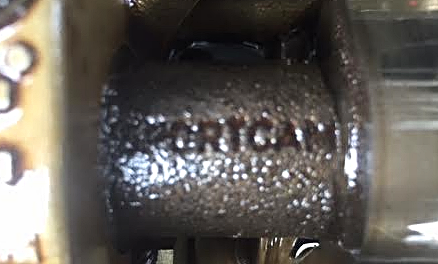
"SPORTCAM" imprinted on the JWT S3 intake cam
TOOLS & THINGS YOU WILL NEED: A jack, jack stands, wheel chocks, socket wrenches, extensions of various lengths, small swivel, pliers, 10mm, 12mm, 14mm, 16mm, 24mm, 27mm sockets. Breaker bar, torque wrench (although you can get by without one). A large 1" open ended wrench, 24mm open ended wrench, long& thin10mm open ended wrench. Flat head screwdriver, standard spark plug removal socket, at least 1 quart of fresh oil, oil filter wrench, zip ties, clean towels, RTV gasket maker sealant, a long magnet extension (just in case). Thin plastic disposable gloves, timing light gun, magnetic tray, a black or blue Sharpie marker. There are also several optional things you can do:
OPTION #1: New valve cover gasket set from Nissan parts department. It can't hurt to get it (about $34 from the parts department) however I've always been able to re-use my old gaskets; it really depends on the condition of your old one, and you won't find out until your remove the valve cover. Order at least a week in advance.
OPTION #2: Upgraded/improved timing chain tensioner & gasket. The timing chain tensioner is a simple and small device with a lock and pin mechanism that enters the block near the oil filter and places the necessary tension on the timing chain, and thus the camshafts, which ultimately drives the motor. Sometime around 1997-1998 Nissan introduced an improved design you can purchase but will cost you anywhere from $60-$100. Again, this is optional. Assuming your old tensioner was in working order, it will come out and go back in fine, and continue to function properly. However if want the better tensioner and don't mind spending the extra cash you may as well get it since you will be removing it anyway. HERE is a (ridiculously) detailed description of the process: http://www.se-r.net/zotz/se-r_tensioner.htm - and you can get the new improved tensioner w/ new gasket from Greg at G-Spec.com.
OPTION #3: 4 fresh quarts of your favorite (preferably synthetic) oil and a filter. It's always a good idea to do an oil change when doing a cam swap. You will leak oil when removing the oil filter and timing chain tensioner anyway, but it's up to you.
OPTION #4: A set of new spark plugs. In my method you will need to remove the spark plug from the #1 cylinder anyway. With the valve cover off it's much easier to access the plugs. Since they're right there, why not? You can get a set of 4 NGK copper BKR6E's for less than $14 a set at AutoZone. Since my spark plugs have probably not been changed in many years, I got the more expensive, NGK iridium plugs, BKR6EIX-11's. They are about twice the price but "last" twice as long.
HERE'S HOW TO DO IT, STEP BY STEP:
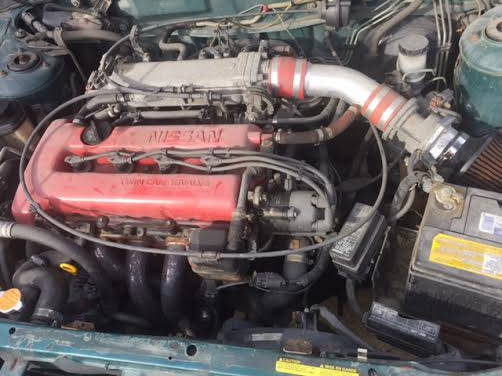
(A very dirty SR20DE in one my SE-R's, about to be opened up)
1) Park the vehicle on a flat, level surface. Engage the emergency brake and put the the transmission in neutral. Disconnect the negative terminal of the battery (usually a 12 or 14mm socket).
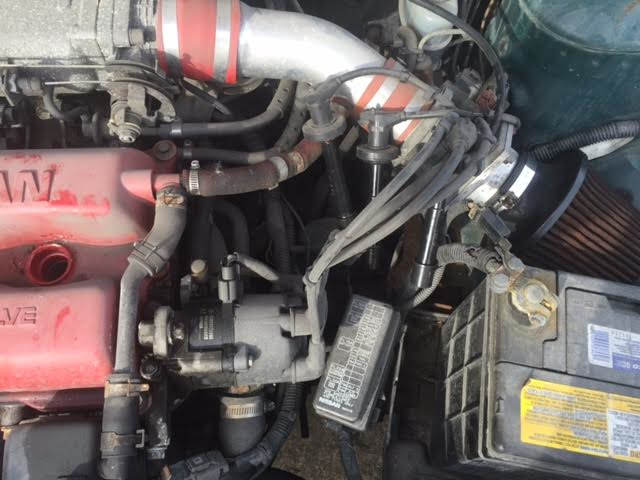
2) Use pliers to open the clamps on the various hoses and pull them away from the valve cover. There's clamps in the hose leading to the intake, another to the canister up front and at the PCV valve on the top left. Remove the spark plug wires from the cylinders leave them connected to the distributor. Pull the throttle cable back towards the firewall and get it out of the way.

3) (Note: the following step applies to the "lowport" 1994+ SR20DE motor. The 1991-1993 motor has different valve cover bolts with acorn nuts instead). Get your wrench and a 10mm socket with an extension of comfortable length for you and start breaking the valve cover bolts loose. They should break fairly easily. Break them loose one by one, going around the cover at random from side to side. Be careful not to drop any (if you lose one you can't just go to Sears Hardware and get a new one). There is washer/grommet that needs to be removed after the bolt slides out, usually with needle nose pliers. Sometimes they come up easily, sometimes you need the pliers. Get a big magnetic tray to put these all in. ALL of the valve cover bolts are identical EXCEPT the center bolt in the middle of the cover between the #2 and #3 cylinders. That bolt is longer and different so make note of it. Take your time and be patient. You will need to remove some of them by hand after they're loosened. Once you get them all you should have something like this in your tray:

4) Now before removing the cover, double check that you've removed all of the bolts and their respective washer/grommets. Some of the bolts are difficult to see and/or access because of things in the way, so either use a swivel or temporarily remove the obstructions.

5) The valve cover should pull off fairly easily and reveal the internals of the motor. Mind the gaskets and make sure you keep them in a safe place if you are not replacing them with new ones. Place the valve cover, the little hoses and the gaskets in a safe place. FROM NOW ON YOU NEED TO BE EXTRA CAREFUL handling your tools and bolt over the engine bay. The effects of a random socket falling down into the motor could be devastating. My motor above had 209,000 miles at the time the photo was taken but was well taken care of (I.E. - regular oil changes). Depending on how well your SR20DE was maintained, it may look better or worse. I was quite pleased with mine.
6) Place the white towel (lint free) over the exposed engine for now to prevent foreign objects from falling into it (you never know!) Get your breaker bar out to loosen the four lug nuts on the front passenger side wheel, then ack up the car on that side and completely remove the wheel. BE CAREFUL. Your car is sharp and heavy. You are soft and squishy. Use quality jack stands and wheel chocks, and NEVER get under a vehicle supported by only a scissor jack.
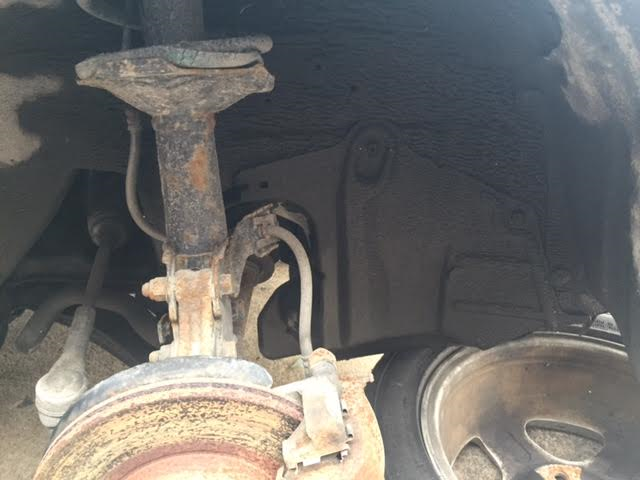
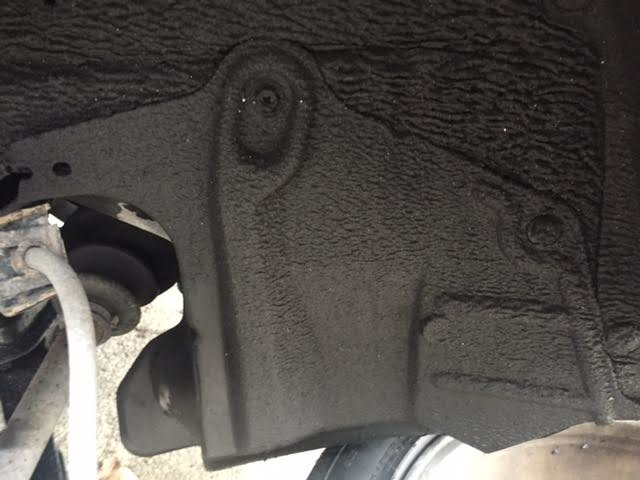
7) Once you've removed the wheel you will see the plastic splash shield. Hopefully yours isn't as filthy as mine was The shield needs to be temporarily removed to access the crank pulley. There are three 10mm bolts you need to remove to bend and pull it out of the way. Now you will see this:
The shield needs to be temporarily removed to access the crank pulley. There are three 10mm bolts you need to remove to bend and pull it out of the way. Now you will see this:
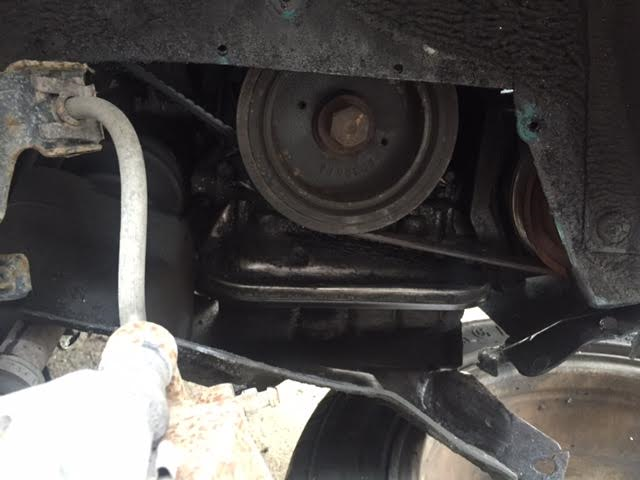
8) You are looking at the crank pulley oil pan (just below the belts). The center bolt on the crank pulley is what we're after here. We need to manually rotate the motor with our breaker bar and 27mm socket (CLOCKWISE) to get the motor to TDC (top dead center). THIS STEP IS ABSOLUTELY CRUCIAL AND PERHAPS THE MOST IMPORTANT OF ALL. If you don't set the motor to TDC and attempt to remove the cams you will damage the valves and possibly worse. There is no room for error so pay close attention:


9) Place the breaker bar and 27mm socket on the crank pulley bolt (as I did above) and leave it there a moment. Remember to have the transmission in neutral. It's not that difficult to rotate the crank but if your bar is extra long you will have to repeatedly readjust your position because you'll run out of room and hit the fenders/strut. FYI, an official definition of TDC is the point where a piston is just about to change from an upward to a downward stroke.
10) It's crucial you get the motor to TDC. To do so and to be 100 percent sure, do the following: remove the spark plug from cylinder #1 using your spark plug removal socket, and place a long, thin screwdriver, or long magnet thingy (like I did) in the cylinder. Use something that is long enough that you can still grab it, obviously. See photo:

Here the spark plug in the #1 cylinder has been removed and a long "magnet thingy" has been inserted in. Why do we do this? Will get to that in a second, but first let me show you how TDC looks on the crank pulley:

THIS IS PROBABLY THE MOST IMPORTANT PART OF THE PROCEDURE:
TDC on the SR20DE is indicated by the pointer being on the SECOND MARK from the LEFT on the crank pulley as well as two other factors: the cam lobes closest to the timing chain (on your left if you're standing in front of the car looking down at the motor) are pointing AWAY from the center of the motor and the cam sprocket dowel pins on the intake & exhaust cams being at 10 and 12 o'clock, respectively. That means on the intake cam (the cam closer to the firewall) the dowel pin should be at 10 o'clock and the exhaust dowel pin should be at 12 o'clock.
So why did we place something long in cylinder #1? This is because as you rotate the crank the screwdriver/magnet thingy/whatever will be pushed up and fall down as it opens and closes. TDC can be achieved when the screwdriver is at it's highest point. For TDC in the SR20DE, you must make sure these four things all occur at the same time:
- The pointer on the crank pulley is pointing to the 2nd mark the from the left
- The camshaft lobes closest to the timing chain are pointing away from the center of the motor
- The screwdriver or whatever you used to put in the #1 spark plug cylinder is at it's highest point
- The intake cam dowel pin shows 10 o'clock; the exhaust cam dowel pin shows 12 o'clock
ALL of these must be present or you are not at TDC. Don't fret though. Rotate the crank pulley clockwise at least another full cycle until all of these are achieved, then we're ready for the next steps.
11) Zip tie the timing chain to the sprockets in at least 4 places, I recommend at least 2 on each side. This ensures the cam timing will not get thrown off:
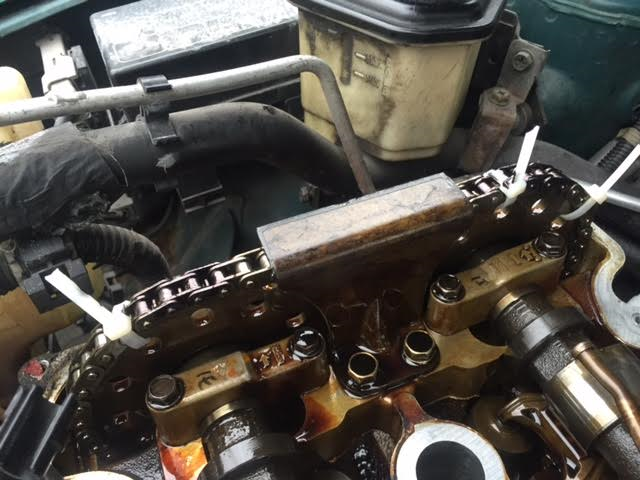
12) Remove the timing chain tensioner. Notice I said "remove" - not block. There are many instructions out there regarding the timing chain tensioner where you put a "wedge" in place to "block" it from putting tension on the chain. I HIGHLY RECOMMEND REMOVING THE TIMING CHAIN TENSIONER AND NOT JUST "BLOCKING" IT. I've seen many problems come from the "block" method, too long to get into here, so just trust me on this one.
To remove the timing chain tensioner:
a) First remove the oil filter, and put a little paper towel or rag under it as it will leak oil a bit. Luckily the SR20 oil filter is in a location where it can be removed when oil is still in the pan. You will now see this:
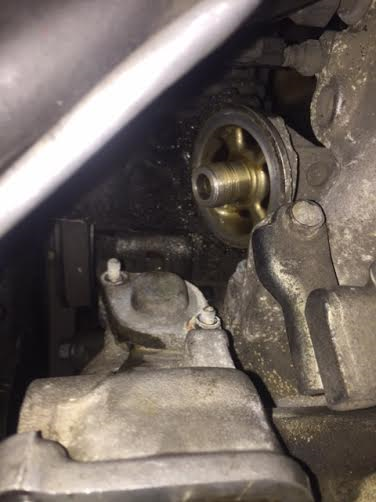
b) See those two extending bolts? That's the timing chain tensioner still installed. Get your wrench and attach a 10mm socket to the nuts (they had already been removed in this photo) and do your best to remove them. You may need to use extensions, a swivel, or even a long open ended 10mm wrench. I'll be honest, they're not the easiest couple of bolts to access. There are also 2 little washers under each bolt so make sure you get them out too. Keep your little rag stuffed in and around the oil filter shaft so nothing falls in there. (NOTE: depending on how well your tensioner is stuck in the block, it may either pop right out when the second nut is removed, OR it may take some "convincing." Be ready and aware of the second nut flying off once it's loosened as the tensioner may pop out with some force. If your SR20 has a lot of miles like mine did, it probably will stay stuck there even when the bolts have been removed. To free it, get a long flat head screwdriver and place the edge between the tensioner and the block and gently tap the end of the screwdriver with a rubber mallet or similar tool. It will eventually pop free. This is the timing chain tensioner removed:
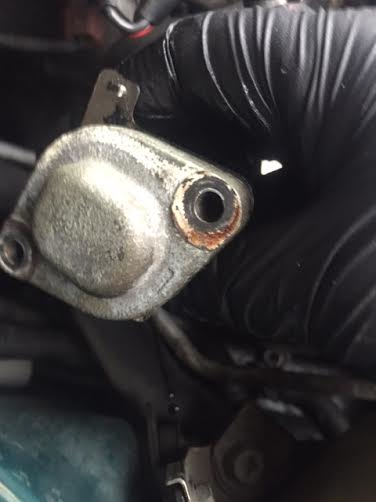
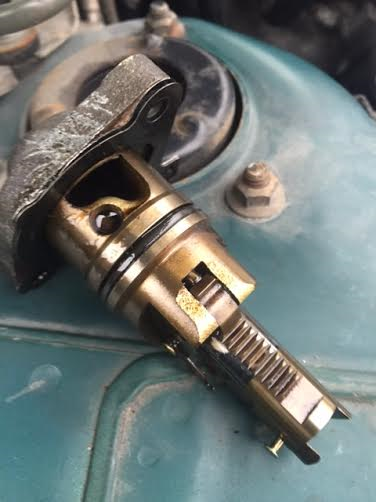
Don't lose it the little gasket! This is the tensioner in it's unlocked position. You will eventually need to compress it and get the hook to attach to the pin before you reinstall it, but for now just set it aside in a safe location, preferably in a plastic cup filled with fresh motor oil.
13) Now the timing chain should have a little more slack in it, so let's start removing what's holding the camshafts in place! First, remove the timing chain guide. It is held on by two 12mm nuts. Use your wrench and an extension. REMEMBER to be careful and extra vigilant not to drop any tools or bolts down into the motor. Photo:

The timing chain guide still attached on the far left.
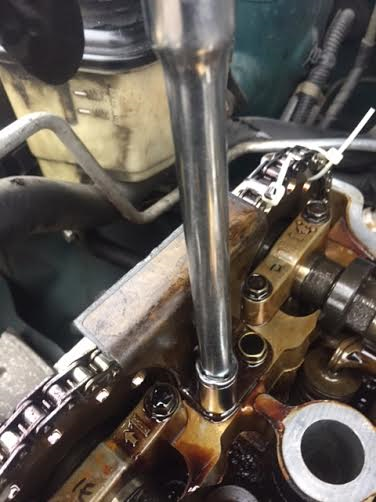
Loosening the 12mm bolts:
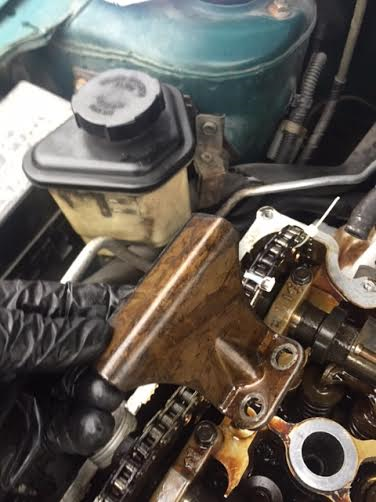
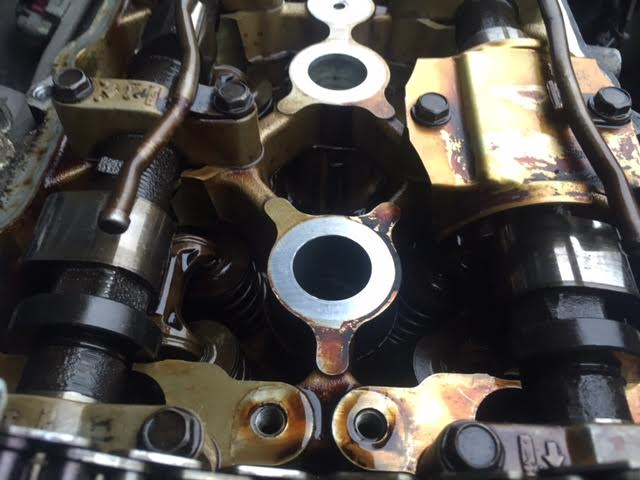
The bolts/washers removed and the guide free, and what it looks like when it's gone. Take note of the first lobes on both intake and exhaust cams facing away from the center of the motor, which is 1 of the indications you are at TDC
Set the timing chain guide and the hardware in safe place free from any dirt or debris it could pick up since it will be oily.
**CONTROVERSY: There is debate among the SR20 community about the timing chain guide being necessary at all. Nissan put the guide in all SR20DE motors from 1991-1997, however in 1998 they completely removed it. The belief is that the guide causes "start up clatter" which sounds like a bunch of nails in a glass jar shaken up for a second or two (especially when the motor is started up on cold mornings). There is also evidence that the guide physically damages the timing chain over time. Whether or not you want to reinstall the guide is completely your choice. Personally, if the motor came with it, I'd put it back in, but you can do your own research on this topic, just Google "SR20DE timing chain guide." Whether or not you put it back or not, just remember that Nissan got rid of it voluntarily in 1998.**
14) Next we want to physically break the camshafts loose from the cam sprockets. You want to break them LOOSE but not actually remove the bolts yet. Depending on your particular motor, this could take a lot of strength. Several years ago on a different SE-R mine were on so tight that to break them free it took a friend standing on his hands, using his legs to push on the breaker bar while I held each cam in place with the wrench! If you're one of those super strong guys I wouldn't worry much, but if not you may want to ask a friend or significant other to help out for a moment.
Attach the 24mm socket to your breaker bar and place it on a main cam bolt. Take your 1" open ended wrench and place it on the first cam hex (it's the little slot before the first lobe) see the photo below:
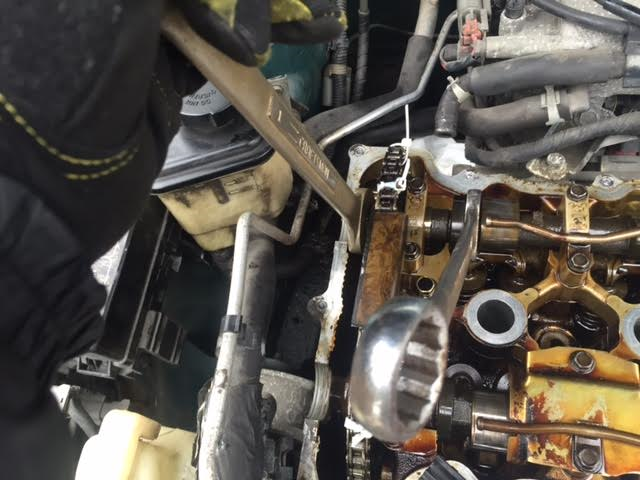
In this photo I actually used a second 1" open ended wrench on the main cam bolt, you can use whichever you wish. You use your right hand to hold the cam in place, and your left to break the bolt loose (make sure you are turning it in the correct direction to loosen!) You must hold the cam in place with the 1" open ended wrench or you will likely rotate the cam, plus you DON'T want to use the motor or timing chain for resistance. Once you break the bolts loose you can stop for now.
15) Now we can remove the distributor. Again, this is my method that I have found works the best. Some would have chosen to remove the distributor earlier, I like to before I begin to remove the cams. The distributor is held on by two 12, sometimes 14mm bolts on it's top and bottom "ears." Removing the distributor also leads you to remove your first cam bearing cap. This one is different than the rest as it's held down by two 12mm bolts:

Since the distributor only effects the exhaust cam I'd advise you start with that cam first. DO 1 CAM AT A TIME. You don't want to mix up which cam bearing caps go where, and you can concentrate on each one a little better.
16) Start breaking loose the cam bearing caps using your wrench, extension and 10mm socket. Break them loose but don't remove. The bolts should take a moderate amount of force with a average wrench. I recommend using an extension as it's easier and gives you a bit of leverage too. Break each bolt free in an "X" like pattern, almost randomly but from separate sides of the cam. Example: loosen one in the middle, then one all the way on the left, then on your right, etc. and keep doing this. You want to loosen the cam slowly from all over and NOT from one end to the other:
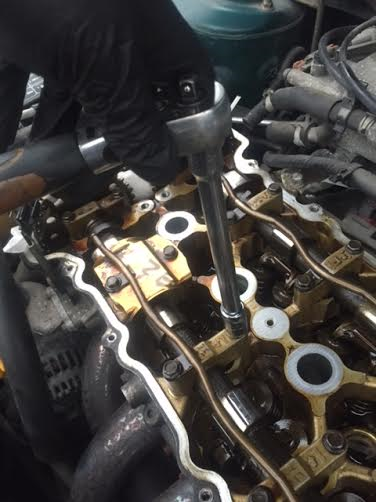
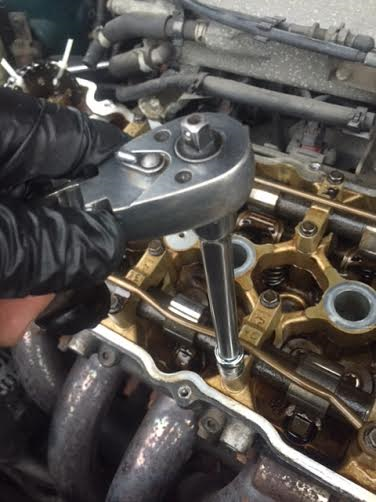
Removing or replacing the cam bearing caps is probably the most time consuming part of the whole process. The bolts are much longer then they appear but are not all the same length. Once all the bolts have been broken loose, continue to move around the cam and loosen them more and more until they come free. Remember to loosen each one a few turns at a time when they're still on tight. Keep everything in order and remember exactly which cap goes where, and where the oil squirters were located.
I recommend:
a) Before you remove each cap, get your sharpie and mark it's location. For example, for the cap closest to the timing chain on the exhaust cam, you would write "1E" - meaning 1 for the first cap and "E" for exhaust. For the 4th intake cam cap write "4I" for fourth cap from the left, and "I" for the intake cam. You get the picture. It would look something like this:
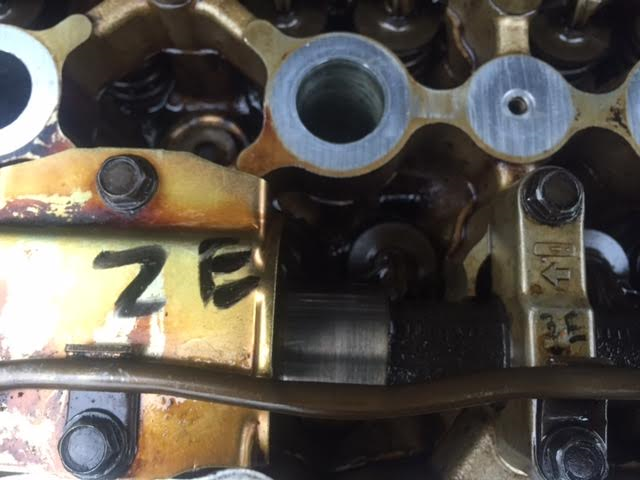
On the oil baffle on the left (which covers the 2nd exhaust cam bearing cap) I wrote "2E" and you can also see I wrote "3E" on the cap to it's right. A very simple thing to do, but a very good idea.
b) Lay out the cam bearing caps in their proper order (and eventually the cams) on a clean towel or piece of cardboard somewhere safe, like this:
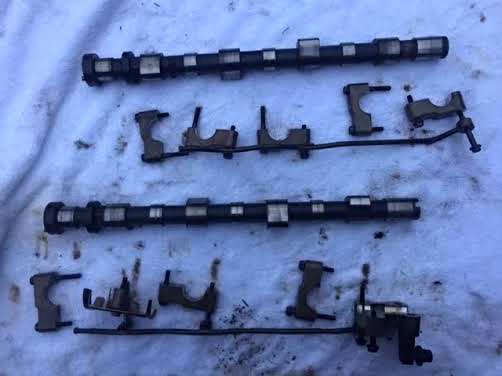
Clearly this photo was taken at the end of my cam removal process. I laid everything out as if I was looking down at the motor from my angle, identical to what I was actually doing. The exhaust cam is on the bottom with it's caps, baffle, and oil squirter in the correct order, and the intake cam on the top laid out the same. I suggest having a designated spot to spread this all out away from your work area, and try to keep the appropriate, matching bolts still inside the caps to minimize confusion (as I also did in the photo).
17) Now let's fully remove the cam sprocket bolts. Do 1 at a time, and after you've gotten them loose enough, turn them by hand like this:
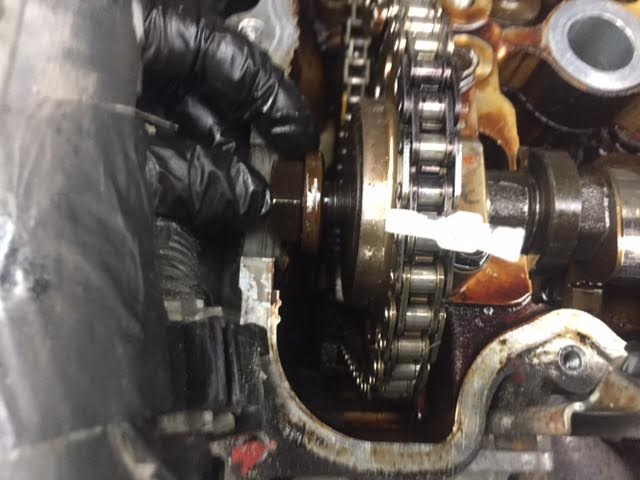
CAUTION: Be very careful not to drop the sprocket bolt or washer down into the motor. I know this is an obvious "duh!" statement but it's happened before! You can never be too careful. I recommend switching to very thin gloves for added dexterity and stuffing a few paper towels between the block and the timing chain (that you can easily pull out) in the unlikely event you drop something.
Once the cam bolts are out the sprockets will come right off the cam dowel pins but remain attached to the timing chain because of your zip ties. Get another zip tie or something similar to hold the chain up as you want to keep it from falling down into the motor. Dropping it or letting it fall can occasionally cause the timing chain to come off down at the crankshaft in which case your cam timing would be off and a pain to correct. This is known as "skipping a tooth on the crank" and it not something you want to deal with, so be careful:
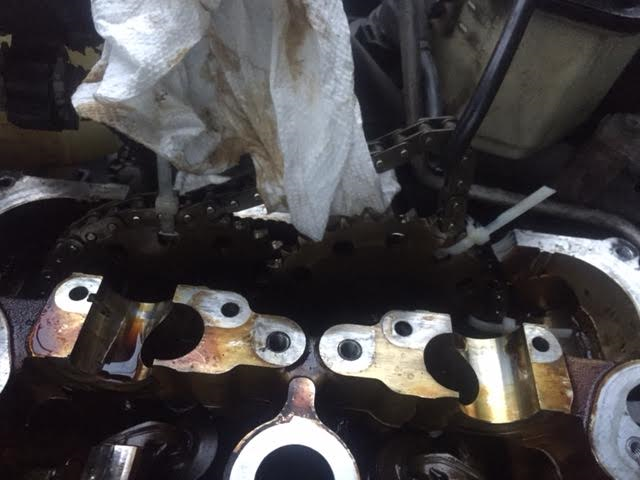
In this photo I actually used an old spark plug wire and a paper towel (it was what I had handy) to hold the chain and sprockets up. Use whatever as long as it works.
18) Now remove the cams from the motor. Sometimes one of the cams will already be loose and come right out, sometimes one will seem "stuck." Don't worry, this is normal. If one seems stuck GENTLY tap on the ends of the cam with a wrench (something dull that won't cause scratches). The cam will pop out. Once the cams are removed there's nothing holding the rocker arms down so pay close attention that none have been disturbed from their perches. If it does happen it's no big deal, simply re-position it by hand like the others are. Your motor will now look like this:
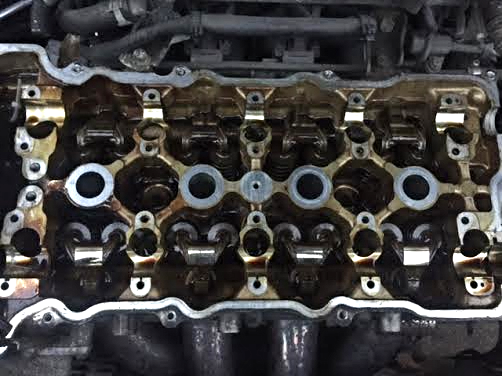

If you purchased new spark plugs now would be a good time to install them. If not, just re-install the one you removed from cylinder #1.
19) Get out your quart of fresh oil and pour a generous amount down onto the rocker arms and everywhere the new cams will be sitting, just avoid the spark plug wells. You can stuff small paper towels down in there to soak any oil that gets near it.
20) Now it's time to basically do everything we just did to remove the cams, just kind of backwards. Again, I suggest doing 1 cam at a time. Oil up each of your new JWT cams and position them. The easiest way to tell which cam goes where is that the exhaust cam has the slot for the distributor on the end. Place the cam with the first lobe pointing away from the center of the motor and with the dowel pin inside the cam sprocket slot. It should slide in easily. Here is a photo of the JWT intake cam positioned in place:
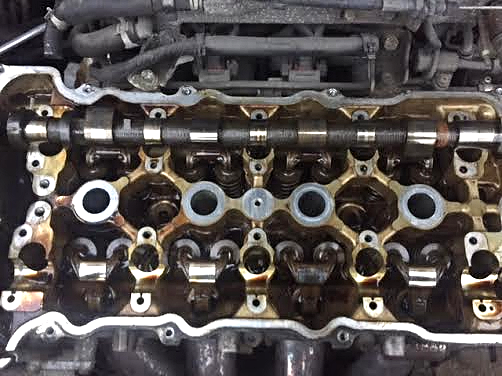
IMPORTANT: It's common for the cam on the driver's side of the motor to be "sticking up" once put in place. Be careful if this happens. I actually broke 2 cam-bearing cap bolts on the driver's side of the engine and had to find replacements. The best way to avoid this, if it happens, is to tighten down the cam bearing caps in what I call a "wave." Start by slightly tightening the bolts on the left side (passenger side of car) and move your way down towards the driver's side of the cam. Tighten in an X pattern. Keep doing this as it will put less pressure on the bolts (which are surprisingly weak) and pull the cam close to it's seated position. Once the cam is seated firmly on both the passenger side, middle, and driver's side, you may start using your torque wrench to tighten them all (again in an X pattern) to the proper specifications.
21) Make sure no rocker arms (and thus, shims) were disturbed from their position and begin to replace the cam bearing caps, one at a time. Hopefully you marked and placed them in proper order after they were removed so it should be fairly easy. TIP: the arrows on each cap always point towards the LEFT or timing chain side of the motor. Tighten each bolt gently by hand until all are in their proper positions then slowly tighten them with your wrench in the same "X" pattern and go from each side of the cam to the other. Left, right, middle. Right, middle, left. You get the picture. Never tighten it down fully in one place before the others are. If you have a torque wrench, once all the bolts are quite tight, tighten them down to about 7.0 ft-lbs each. For the exhaust cam, the two 12mm bolts at the distributor should be tightened to about 16 ft-lbs. MAKE SURE THE ROTOR ON THE DISTRIBUTOR FITS IN WITH THE CAM SLOT!! You may need a second person to position and push the distributor into the proper location while you tighten the bolts. If you don't have a torque wrench, tighten all the bolts to the same amount to the best of your ability. Recall how much effort it took to originally loosen them and try to get them to that point. It may take some trial and error of tightening one and loosening it to get the "feel." My point is: it's always best to have a torque wrench!
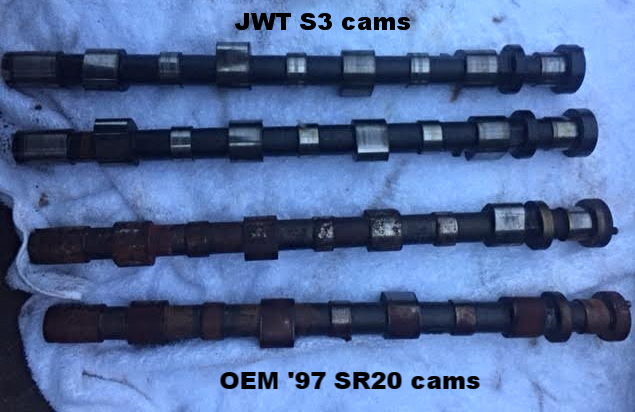
IMPORTANT NOTE: If you have already advanced your ignition timing by moving the distributor, disregard the "JWT SR20 camshaft install" instructions which are found at: http://jimwolftechnology.com/wolfpdf/caminstallinstforsr20.pdf - if you look at that page, you'll see that JWT says that your distributor is only in the proper position if it's in the center. This is not true if you have previously advanced your ignition timing (like many SR20 enthusiasts do to gain a few free HP). To make it simple: the distributor should be replaced in the same position it was before you started the cam install.
22) Tighten the sprocket bolts in by hand. Make sure each sprocket is mated correctly to the cam with the dowel pins and then start to make the bolts tighter. Use your big open end wrenches once again on the first cam hex (to hold each cam in place) and the other on the actual sprocket bolt to tighten it. Once the cam is seated well get out the breaker bar and 24mm socket and tighten them with that while still holding the first cam hex in place with your wrench. If you have a torque wrench that goes up high enough, tighten each of them to 110 ft-lbs. Again if you don't have one, just tighten them really really well (again recall how much effort it took to loosen them originally).
23) Carefully remove any zip ties you placed on the sprockets and chain, and replace the timing chain tensioner. This can be a tedious procedure if your hands are big, or if you don't have enough light. My suggestion: get plenty of light shining down there and be patient. First, you must compress it and attach the little arm to the pin. This can be done by placing it on a hard surface (the ground) and pushing down with one hand, then using your other hand to get the arm to latch to the pin. When replacing it, make sure it is oriented correctly with the gasket and be very careful not to drop the little washers anywhere. Keep your paper towel or rag jammed in oil filter hole. Take your time and use your swivels and/or temporarily remove hoses that get in the way if needed. The tensioner should now be snug.
24) Replace the oil filter. Coat it with a layer of oil and tighten about as much as you can by hand (as usual).
25) Get your breaker bar and the 27mm socket and rotate the crank clockwise about 1/4 of a turn to fully engage the timing chain tensioner. If you have a friend helping you out, this would be a good time to watch that both the intake & exhaust cams rotate smoothly. ONCE AGAIN, double check your work. Make sure no rocker arms were disturbed, all arrows on the cam bearing caps point towards the PASSENGER side of the car, and all bolts are snug.
26) Get your RTV sealant out and dab some in the area of the "half moons" of the valve cover gasket. Make sure the spark plug gasket is still lodged up in the valve cover (it often is) - carefully place the valve cover back on the block, making sure the gasket remains in place. Replace the valve cover gasket bolts and washers. There is 1 long valve cover bolt that goes in the center between the 2nd and 3rd spark plug wells (FYI). Tighten them from left to right and middle, slowly and evenly. Never tighten one all the way. Keep tightening randomly all over the valve cover until it is properly seated. If you have a torque wrench, all the valve cover bolts should be torqued down to about 7.0 ft-lbs.
27) Replace all hoses that lead to the valve cover you had removed, use pliers on the clamps. Replace the spark plug wires in the proper order.
28) Double check everything (no loose tools in the engine bay, all wires and hoses are connected, etc.) Reconnect the battery!
29) Start up the motor. DON'T WORRY! If you did everything correct it may still run a little funny but will smooth out. The motor will "lope" at little, this is normal with a bigger cam for the SR20. If the cams are brand new you should keep the motor under 4000RPM for 20-30 miles of driving to make sure they are properly "broken in" and keep it under WOT for a couple days or regular driving.
30) You're done! Now go get em!! If you have any questions e-mail me at [email]Jordan@jordanwhitemusic.com[/email]
 (as seen at Jordan White's SR20VE/SR20DE Mini-Site )
(as seen at Jordan White's SR20VE/SR20DE Mini-Site )Some of this information may be redundant for those of you who are quite experienced with these motors, and truth be told, this was actually my 6th cam swap in a SR20, but I decided to photograph and document it anyway. There are some write ups on the internet on how to do this, but I found they skip steps or don't mention some important aspects. So this write up is aimed towards those who are newer to the SR20DE motor and/or who are learning how to work on and upgrade their own cars. My way is my way and you may have a better way, but of course I must post this DISCLAIMER that I'm not responsible if you try any of these methods and something goes wrong. It is very easy to ruin an SR20 motor if you're not careful during a cam swap. Here's some things I've seen during cam swaps that have ruined or nearly ruined SR20 motors:
1) The motor not being at TDC (top dead center) before beginning
2) Skipping a tooth on the timing chain down at the crank; screwing up the cam timing
3) Dropping a bolt, washer, socket, etc. down into the motor
4) Trying to use a "wedge" to block the timing chain tensioner instead of removing it (more on that later)
5) Not removing or replacing the cam bearing caps in the proper way
6) Generally goofing off and not paying attention, not checking and re-checking your work
That being said, while not being especially "difficult" - a cam swap in the SR20 motor is not to be taken lightly. It's a time consuming and involved process. You are basically doing heart surgery on your motor and must exercise caution and pay full attention. Eliminate distractions the best you can and if possible, have a friend at least somewhat familiar with working on cars help you out. DON'T RUSH. Allow yourself at least twice the amount of time to complete the job. If you're working outside and it starts to get dark, STOP. Don't try to beat the sunlight. Avoid drinking too many beers as it will dull your senses (I know for some of us that's part of the fun) - but trust me, you don't want to mess anything up. While many things can go wrong, if you do it right, the results are quite rewarding


"SPORTCAM" imprinted on the JWT S3 intake cam
TOOLS & THINGS YOU WILL NEED: A jack, jack stands, wheel chocks, socket wrenches, extensions of various lengths, small swivel, pliers, 10mm, 12mm, 14mm, 16mm, 24mm, 27mm sockets. Breaker bar, torque wrench (although you can get by without one). A large 1" open ended wrench, 24mm open ended wrench, long& thin10mm open ended wrench. Flat head screwdriver, standard spark plug removal socket, at least 1 quart of fresh oil, oil filter wrench, zip ties, clean towels, RTV gasket maker sealant, a long magnet extension (just in case). Thin plastic disposable gloves, timing light gun, magnetic tray, a black or blue Sharpie marker. There are also several optional things you can do:
OPTION #1: New valve cover gasket set from Nissan parts department. It can't hurt to get it (about $34 from the parts department) however I've always been able to re-use my old gaskets; it really depends on the condition of your old one, and you won't find out until your remove the valve cover. Order at least a week in advance.
OPTION #2: Upgraded/improved timing chain tensioner & gasket. The timing chain tensioner is a simple and small device with a lock and pin mechanism that enters the block near the oil filter and places the necessary tension on the timing chain, and thus the camshafts, which ultimately drives the motor. Sometime around 1997-1998 Nissan introduced an improved design you can purchase but will cost you anywhere from $60-$100. Again, this is optional. Assuming your old tensioner was in working order, it will come out and go back in fine, and continue to function properly. However if want the better tensioner and don't mind spending the extra cash you may as well get it since you will be removing it anyway. HERE is a (ridiculously) detailed description of the process: http://www.se-r.net/zotz/se-r_tensioner.htm - and you can get the new improved tensioner w/ new gasket from Greg at G-Spec.com.
OPTION #3: 4 fresh quarts of your favorite (preferably synthetic) oil and a filter. It's always a good idea to do an oil change when doing a cam swap. You will leak oil when removing the oil filter and timing chain tensioner anyway, but it's up to you.
OPTION #4: A set of new spark plugs. In my method you will need to remove the spark plug from the #1 cylinder anyway. With the valve cover off it's much easier to access the plugs. Since they're right there, why not? You can get a set of 4 NGK copper BKR6E's for less than $14 a set at AutoZone. Since my spark plugs have probably not been changed in many years, I got the more expensive, NGK iridium plugs, BKR6EIX-11's. They are about twice the price but "last" twice as long.
HERE'S HOW TO DO IT, STEP BY STEP:

(A very dirty SR20DE in one my SE-R's, about to be opened up)
1) Park the vehicle on a flat, level surface. Engage the emergency brake and put the the transmission in neutral. Disconnect the negative terminal of the battery (usually a 12 or 14mm socket).

2) Use pliers to open the clamps on the various hoses and pull them away from the valve cover. There's clamps in the hose leading to the intake, another to the canister up front and at the PCV valve on the top left. Remove the spark plug wires from the cylinders leave them connected to the distributor. Pull the throttle cable back towards the firewall and get it out of the way.

3) (Note: the following step applies to the "lowport" 1994+ SR20DE motor. The 1991-1993 motor has different valve cover bolts with acorn nuts instead). Get your wrench and a 10mm socket with an extension of comfortable length for you and start breaking the valve cover bolts loose. They should break fairly easily. Break them loose one by one, going around the cover at random from side to side. Be careful not to drop any (if you lose one you can't just go to Sears Hardware and get a new one). There is washer/grommet that needs to be removed after the bolt slides out, usually with needle nose pliers. Sometimes they come up easily, sometimes you need the pliers. Get a big magnetic tray to put these all in. ALL of the valve cover bolts are identical EXCEPT the center bolt in the middle of the cover between the #2 and #3 cylinders. That bolt is longer and different so make note of it. Take your time and be patient. You will need to remove some of them by hand after they're loosened. Once you get them all you should have something like this in your tray:

4) Now before removing the cover, double check that you've removed all of the bolts and their respective washer/grommets. Some of the bolts are difficult to see and/or access because of things in the way, so either use a swivel or temporarily remove the obstructions.

5) The valve cover should pull off fairly easily and reveal the internals of the motor. Mind the gaskets and make sure you keep them in a safe place if you are not replacing them with new ones. Place the valve cover, the little hoses and the gaskets in a safe place. FROM NOW ON YOU NEED TO BE EXTRA CAREFUL handling your tools and bolt over the engine bay. The effects of a random socket falling down into the motor could be devastating. My motor above had 209,000 miles at the time the photo was taken but was well taken care of (I.E. - regular oil changes). Depending on how well your SR20DE was maintained, it may look better or worse. I was quite pleased with mine.
6) Place the white towel (lint free) over the exposed engine for now to prevent foreign objects from falling into it (you never know!) Get your breaker bar out to loosen the four lug nuts on the front passenger side wheel, then ack up the car on that side and completely remove the wheel. BE CAREFUL. Your car is sharp and heavy. You are soft and squishy. Use quality jack stands and wheel chocks, and NEVER get under a vehicle supported by only a scissor jack.


7) Once you've removed the wheel you will see the plastic splash shield. Hopefully yours isn't as filthy as mine was
 The shield needs to be temporarily removed to access the crank pulley. There are three 10mm bolts you need to remove to bend and pull it out of the way. Now you will see this:
The shield needs to be temporarily removed to access the crank pulley. There are three 10mm bolts you need to remove to bend and pull it out of the way. Now you will see this:
8) You are looking at the crank pulley oil pan (just below the belts). The center bolt on the crank pulley is what we're after here. We need to manually rotate the motor with our breaker bar and 27mm socket (CLOCKWISE) to get the motor to TDC (top dead center). THIS STEP IS ABSOLUTELY CRUCIAL AND PERHAPS THE MOST IMPORTANT OF ALL. If you don't set the motor to TDC and attempt to remove the cams you will damage the valves and possibly worse. There is no room for error so pay close attention:


9) Place the breaker bar and 27mm socket on the crank pulley bolt (as I did above) and leave it there a moment. Remember to have the transmission in neutral. It's not that difficult to rotate the crank but if your bar is extra long you will have to repeatedly readjust your position because you'll run out of room and hit the fenders/strut. FYI, an official definition of TDC is the point where a piston is just about to change from an upward to a downward stroke.
10) It's crucial you get the motor to TDC. To do so and to be 100 percent sure, do the following: remove the spark plug from cylinder #1 using your spark plug removal socket, and place a long, thin screwdriver, or long magnet thingy (like I did) in the cylinder. Use something that is long enough that you can still grab it, obviously. See photo:

Here the spark plug in the #1 cylinder has been removed and a long "magnet thingy" has been inserted in. Why do we do this? Will get to that in a second, but first let me show you how TDC looks on the crank pulley:

THIS IS PROBABLY THE MOST IMPORTANT PART OF THE PROCEDURE:
TDC on the SR20DE is indicated by the pointer being on the SECOND MARK from the LEFT on the crank pulley as well as two other factors: the cam lobes closest to the timing chain (on your left if you're standing in front of the car looking down at the motor) are pointing AWAY from the center of the motor and the cam sprocket dowel pins on the intake & exhaust cams being at 10 and 12 o'clock, respectively. That means on the intake cam (the cam closer to the firewall) the dowel pin should be at 10 o'clock and the exhaust dowel pin should be at 12 o'clock.
So why did we place something long in cylinder #1? This is because as you rotate the crank the screwdriver/magnet thingy/whatever will be pushed up and fall down as it opens and closes. TDC can be achieved when the screwdriver is at it's highest point. For TDC in the SR20DE, you must make sure these four things all occur at the same time:
- The pointer on the crank pulley is pointing to the 2nd mark the from the left
- The camshaft lobes closest to the timing chain are pointing away from the center of the motor
- The screwdriver or whatever you used to put in the #1 spark plug cylinder is at it's highest point
- The intake cam dowel pin shows 10 o'clock; the exhaust cam dowel pin shows 12 o'clock
ALL of these must be present or you are not at TDC. Don't fret though. Rotate the crank pulley clockwise at least another full cycle until all of these are achieved, then we're ready for the next steps.
11) Zip tie the timing chain to the sprockets in at least 4 places, I recommend at least 2 on each side. This ensures the cam timing will not get thrown off:

12) Remove the timing chain tensioner. Notice I said "remove" - not block. There are many instructions out there regarding the timing chain tensioner where you put a "wedge" in place to "block" it from putting tension on the chain. I HIGHLY RECOMMEND REMOVING THE TIMING CHAIN TENSIONER AND NOT JUST "BLOCKING" IT. I've seen many problems come from the "block" method, too long to get into here, so just trust me on this one.
To remove the timing chain tensioner:
a) First remove the oil filter, and put a little paper towel or rag under it as it will leak oil a bit. Luckily the SR20 oil filter is in a location where it can be removed when oil is still in the pan. You will now see this:

b) See those two extending bolts? That's the timing chain tensioner still installed. Get your wrench and attach a 10mm socket to the nuts (they had already been removed in this photo) and do your best to remove them. You may need to use extensions, a swivel, or even a long open ended 10mm wrench. I'll be honest, they're not the easiest couple of bolts to access. There are also 2 little washers under each bolt so make sure you get them out too. Keep your little rag stuffed in and around the oil filter shaft so nothing falls in there. (NOTE: depending on how well your tensioner is stuck in the block, it may either pop right out when the second nut is removed, OR it may take some "convincing." Be ready and aware of the second nut flying off once it's loosened as the tensioner may pop out with some force. If your SR20 has a lot of miles like mine did, it probably will stay stuck there even when the bolts have been removed. To free it, get a long flat head screwdriver and place the edge between the tensioner and the block and gently tap the end of the screwdriver with a rubber mallet or similar tool. It will eventually pop free. This is the timing chain tensioner removed:


Don't lose it the little gasket! This is the tensioner in it's unlocked position. You will eventually need to compress it and get the hook to attach to the pin before you reinstall it, but for now just set it aside in a safe location, preferably in a plastic cup filled with fresh motor oil.
13) Now the timing chain should have a little more slack in it, so let's start removing what's holding the camshafts in place! First, remove the timing chain guide. It is held on by two 12mm nuts. Use your wrench and an extension. REMEMBER to be careful and extra vigilant not to drop any tools or bolts down into the motor. Photo:

The timing chain guide still attached on the far left.

Loosening the 12mm bolts:


The bolts/washers removed and the guide free, and what it looks like when it's gone. Take note of the first lobes on both intake and exhaust cams facing away from the center of the motor, which is 1 of the indications you are at TDC

Set the timing chain guide and the hardware in safe place free from any dirt or debris it could pick up since it will be oily.
**CONTROVERSY: There is debate among the SR20 community about the timing chain guide being necessary at all. Nissan put the guide in all SR20DE motors from 1991-1997, however in 1998 they completely removed it. The belief is that the guide causes "start up clatter" which sounds like a bunch of nails in a glass jar shaken up for a second or two (especially when the motor is started up on cold mornings). There is also evidence that the guide physically damages the timing chain over time. Whether or not you want to reinstall the guide is completely your choice. Personally, if the motor came with it, I'd put it back in, but you can do your own research on this topic, just Google "SR20DE timing chain guide." Whether or not you put it back or not, just remember that Nissan got rid of it voluntarily in 1998.**
14) Next we want to physically break the camshafts loose from the cam sprockets. You want to break them LOOSE but not actually remove the bolts yet. Depending on your particular motor, this could take a lot of strength. Several years ago on a different SE-R mine were on so tight that to break them free it took a friend standing on his hands, using his legs to push on the breaker bar while I held each cam in place with the wrench! If you're one of those super strong guys I wouldn't worry much, but if not you may want to ask a friend or significant other to help out for a moment.
Attach the 24mm socket to your breaker bar and place it on a main cam bolt. Take your 1" open ended wrench and place it on the first cam hex (it's the little slot before the first lobe) see the photo below:

In this photo I actually used a second 1" open ended wrench on the main cam bolt, you can use whichever you wish. You use your right hand to hold the cam in place, and your left to break the bolt loose (make sure you are turning it in the correct direction to loosen!) You must hold the cam in place with the 1" open ended wrench or you will likely rotate the cam, plus you DON'T want to use the motor or timing chain for resistance. Once you break the bolts loose you can stop for now.
15) Now we can remove the distributor. Again, this is my method that I have found works the best. Some would have chosen to remove the distributor earlier, I like to before I begin to remove the cams. The distributor is held on by two 12, sometimes 14mm bolts on it's top and bottom "ears." Removing the distributor also leads you to remove your first cam bearing cap. This one is different than the rest as it's held down by two 12mm bolts:

Since the distributor only effects the exhaust cam I'd advise you start with that cam first. DO 1 CAM AT A TIME. You don't want to mix up which cam bearing caps go where, and you can concentrate on each one a little better.
16) Start breaking loose the cam bearing caps using your wrench, extension and 10mm socket. Break them loose but don't remove. The bolts should take a moderate amount of force with a average wrench. I recommend using an extension as it's easier and gives you a bit of leverage too. Break each bolt free in an "X" like pattern, almost randomly but from separate sides of the cam. Example: loosen one in the middle, then one all the way on the left, then on your right, etc. and keep doing this. You want to loosen the cam slowly from all over and NOT from one end to the other:


Removing or replacing the cam bearing caps is probably the most time consuming part of the whole process. The bolts are much longer then they appear but are not all the same length. Once all the bolts have been broken loose, continue to move around the cam and loosen them more and more until they come free. Remember to loosen each one a few turns at a time when they're still on tight. Keep everything in order and remember exactly which cap goes where, and where the oil squirters were located.
I recommend:
a) Before you remove each cap, get your sharpie and mark it's location. For example, for the cap closest to the timing chain on the exhaust cam, you would write "1E" - meaning 1 for the first cap and "E" for exhaust. For the 4th intake cam cap write "4I" for fourth cap from the left, and "I" for the intake cam. You get the picture. It would look something like this:

On the oil baffle on the left (which covers the 2nd exhaust cam bearing cap) I wrote "2E" and you can also see I wrote "3E" on the cap to it's right. A very simple thing to do, but a very good idea.
b) Lay out the cam bearing caps in their proper order (and eventually the cams) on a clean towel or piece of cardboard somewhere safe, like this:

Clearly this photo was taken at the end of my cam removal process. I laid everything out as if I was looking down at the motor from my angle, identical to what I was actually doing. The exhaust cam is on the bottom with it's caps, baffle, and oil squirter in the correct order, and the intake cam on the top laid out the same. I suggest having a designated spot to spread this all out away from your work area, and try to keep the appropriate, matching bolts still inside the caps to minimize confusion (as I also did in the photo).
17) Now let's fully remove the cam sprocket bolts. Do 1 at a time, and after you've gotten them loose enough, turn them by hand like this:

CAUTION: Be very careful not to drop the sprocket bolt or washer down into the motor. I know this is an obvious "duh!" statement but it's happened before! You can never be too careful. I recommend switching to very thin gloves for added dexterity and stuffing a few paper towels between the block and the timing chain (that you can easily pull out) in the unlikely event you drop something.
Once the cam bolts are out the sprockets will come right off the cam dowel pins but remain attached to the timing chain because of your zip ties. Get another zip tie or something similar to hold the chain up as you want to keep it from falling down into the motor. Dropping it or letting it fall can occasionally cause the timing chain to come off down at the crankshaft in which case your cam timing would be off and a pain to correct. This is known as "skipping a tooth on the crank" and it not something you want to deal with, so be careful:

In this photo I actually used an old spark plug wire and a paper towel (it was what I had handy) to hold the chain and sprockets up. Use whatever as long as it works.
18) Now remove the cams from the motor. Sometimes one of the cams will already be loose and come right out, sometimes one will seem "stuck." Don't worry, this is normal. If one seems stuck GENTLY tap on the ends of the cam with a wrench (something dull that won't cause scratches). The cam will pop out. Once the cams are removed there's nothing holding the rocker arms down so pay close attention that none have been disturbed from their perches. If it does happen it's no big deal, simply re-position it by hand like the others are. Your motor will now look like this:


If you purchased new spark plugs now would be a good time to install them. If not, just re-install the one you removed from cylinder #1.
19) Get out your quart of fresh oil and pour a generous amount down onto the rocker arms and everywhere the new cams will be sitting, just avoid the spark plug wells. You can stuff small paper towels down in there to soak any oil that gets near it.
20) Now it's time to basically do everything we just did to remove the cams, just kind of backwards. Again, I suggest doing 1 cam at a time. Oil up each of your new JWT cams and position them. The easiest way to tell which cam goes where is that the exhaust cam has the slot for the distributor on the end. Place the cam with the first lobe pointing away from the center of the motor and with the dowel pin inside the cam sprocket slot. It should slide in easily. Here is a photo of the JWT intake cam positioned in place:

IMPORTANT: It's common for the cam on the driver's side of the motor to be "sticking up" once put in place. Be careful if this happens. I actually broke 2 cam-bearing cap bolts on the driver's side of the engine and had to find replacements. The best way to avoid this, if it happens, is to tighten down the cam bearing caps in what I call a "wave." Start by slightly tightening the bolts on the left side (passenger side of car) and move your way down towards the driver's side of the cam. Tighten in an X pattern. Keep doing this as it will put less pressure on the bolts (which are surprisingly weak) and pull the cam close to it's seated position. Once the cam is seated firmly on both the passenger side, middle, and driver's side, you may start using your torque wrench to tighten them all (again in an X pattern) to the proper specifications.
21) Make sure no rocker arms (and thus, shims) were disturbed from their position and begin to replace the cam bearing caps, one at a time. Hopefully you marked and placed them in proper order after they were removed so it should be fairly easy. TIP: the arrows on each cap always point towards the LEFT or timing chain side of the motor. Tighten each bolt gently by hand until all are in their proper positions then slowly tighten them with your wrench in the same "X" pattern and go from each side of the cam to the other. Left, right, middle. Right, middle, left. You get the picture. Never tighten it down fully in one place before the others are. If you have a torque wrench, once all the bolts are quite tight, tighten them down to about 7.0 ft-lbs each. For the exhaust cam, the two 12mm bolts at the distributor should be tightened to about 16 ft-lbs. MAKE SURE THE ROTOR ON THE DISTRIBUTOR FITS IN WITH THE CAM SLOT!! You may need a second person to position and push the distributor into the proper location while you tighten the bolts. If you don't have a torque wrench, tighten all the bolts to the same amount to the best of your ability. Recall how much effort it took to originally loosen them and try to get them to that point. It may take some trial and error of tightening one and loosening it to get the "feel." My point is: it's always best to have a torque wrench!

IMPORTANT NOTE: If you have already advanced your ignition timing by moving the distributor, disregard the "JWT SR20 camshaft install" instructions which are found at: http://jimwolftechnology.com/wolfpdf/caminstallinstforsr20.pdf - if you look at that page, you'll see that JWT says that your distributor is only in the proper position if it's in the center. This is not true if you have previously advanced your ignition timing (like many SR20 enthusiasts do to gain a few free HP). To make it simple: the distributor should be replaced in the same position it was before you started the cam install.
22) Tighten the sprocket bolts in by hand. Make sure each sprocket is mated correctly to the cam with the dowel pins and then start to make the bolts tighter. Use your big open end wrenches once again on the first cam hex (to hold each cam in place) and the other on the actual sprocket bolt to tighten it. Once the cam is seated well get out the breaker bar and 24mm socket and tighten them with that while still holding the first cam hex in place with your wrench. If you have a torque wrench that goes up high enough, tighten each of them to 110 ft-lbs. Again if you don't have one, just tighten them really really well (again recall how much effort it took to loosen them originally).
23) Carefully remove any zip ties you placed on the sprockets and chain, and replace the timing chain tensioner. This can be a tedious procedure if your hands are big, or if you don't have enough light. My suggestion: get plenty of light shining down there and be patient. First, you must compress it and attach the little arm to the pin. This can be done by placing it on a hard surface (the ground) and pushing down with one hand, then using your other hand to get the arm to latch to the pin. When replacing it, make sure it is oriented correctly with the gasket and be very careful not to drop the little washers anywhere. Keep your paper towel or rag jammed in oil filter hole. Take your time and use your swivels and/or temporarily remove hoses that get in the way if needed. The tensioner should now be snug.
24) Replace the oil filter. Coat it with a layer of oil and tighten about as much as you can by hand (as usual).
25) Get your breaker bar and the 27mm socket and rotate the crank clockwise about 1/4 of a turn to fully engage the timing chain tensioner. If you have a friend helping you out, this would be a good time to watch that both the intake & exhaust cams rotate smoothly. ONCE AGAIN, double check your work. Make sure no rocker arms were disturbed, all arrows on the cam bearing caps point towards the PASSENGER side of the car, and all bolts are snug.
26) Get your RTV sealant out and dab some in the area of the "half moons" of the valve cover gasket. Make sure the spark plug gasket is still lodged up in the valve cover (it often is) - carefully place the valve cover back on the block, making sure the gasket remains in place. Replace the valve cover gasket bolts and washers. There is 1 long valve cover bolt that goes in the center between the 2nd and 3rd spark plug wells (FYI). Tighten them from left to right and middle, slowly and evenly. Never tighten one all the way. Keep tightening randomly all over the valve cover until it is properly seated. If you have a torque wrench, all the valve cover bolts should be torqued down to about 7.0 ft-lbs.
27) Replace all hoses that lead to the valve cover you had removed, use pliers on the clamps. Replace the spark plug wires in the proper order.
28) Double check everything (no loose tools in the engine bay, all wires and hoses are connected, etc.) Reconnect the battery!
29) Start up the motor. DON'T WORRY! If you did everything correct it may still run a little funny but will smooth out. The motor will "lope" at little, this is normal with a bigger cam for the SR20. If the cams are brand new you should keep the motor under 4000RPM for 20-30 miles of driving to make sure they are properly "broken in" and keep it under WOT for a couple days or regular driving.
30) You're done! Now go get em!! If you have any questions e-mail me at [email]Jordan@jordanwhitemusic.com[/email]
Last edited by Storm88000
on 2016-02-24
at 04-07-10.









 Great info to have online.
Great info to have online.

 Back to top
Back to top
